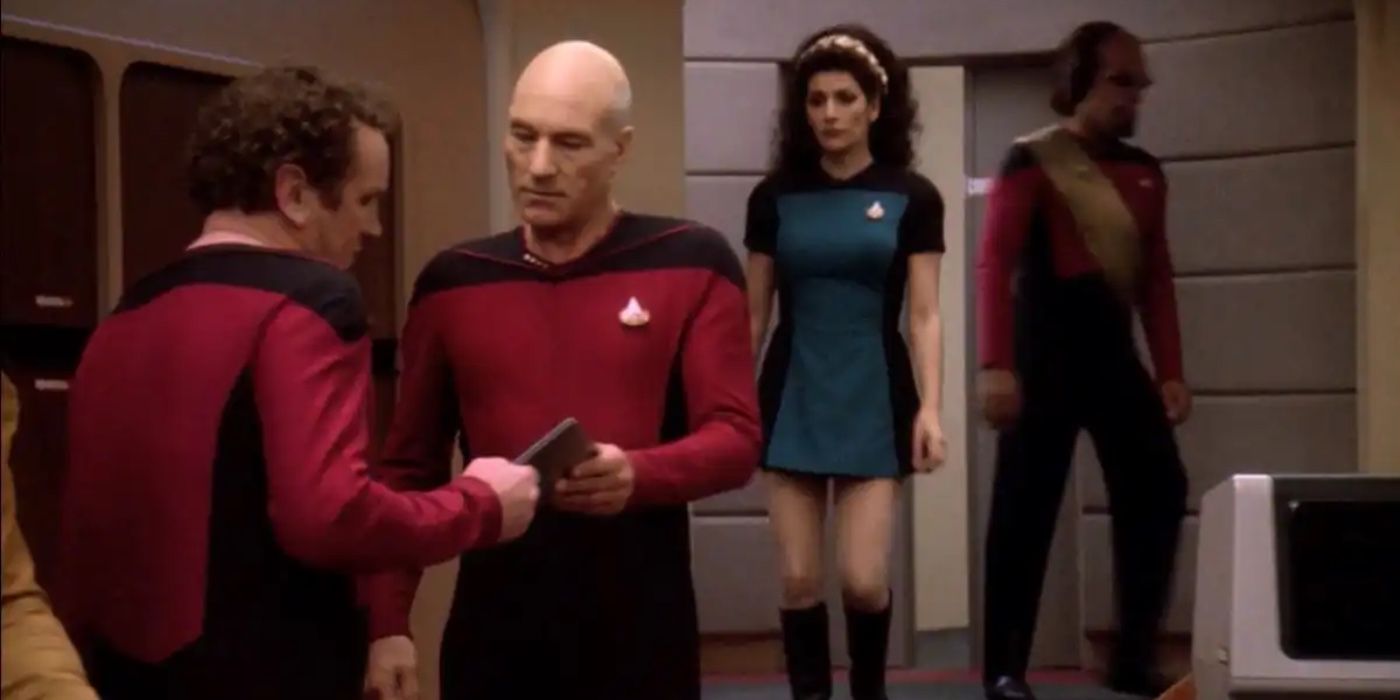In the early seasons of Star Trek: The Next Generation, male crewmembers on the Enterprise appeared wearing the skant uniform, the minidress sometimes worn by female crewmates, but this was abandoned after only a few brief scenes. It was a bold and controversial move on television in the eighties, even though these skant-clad men were only relegated to the background. Initially appearing in early seasons of TNG, the Star Trek series dropped the idea of men in the minidress without comment. The Starfleet uniforms have changed many times in the show’s history, but it was strange for this change to come and go so suddenly. Although it was rumored that the network disapproved of this low-key progressive move, the male skant was likely dropped for a more practical reason.
The skant uniform seen on male officers was identical to the one worn by female characters in the early seasons. Both Deanna Troi and Tasha Yar wore the skant during scenes of “Encounter at Farpoint,” and female background characters continued to wear the skant in first two seasons. It was a successor to the Star Trek: The Original Series minidress that all women wore. Part of the reason the showrunners included men in skants was to make a statement following the changing perspective on TOS’ minidresses. The short-skirted uniform worn by female crew in TOS was intended as a feminist decision, but like many things about Star Trek, it didn’t age well and needed to be salvaged if it was going to be used in The Next Generation.
According to Uhura actress Nichelle Nichols, the miniskirts didn’t carry the same sexist baggage for her in the ‘60s. Instead, they showed that the women of Starfleet were liberated and respected in their jobs no matter what they wore. However, over the following decades, fans started to feel putting the women in miniskirts while the men wore uniform pants was demeaning. When minidresses were revived for the sequel series, the uniform needed to seem less like an excuse to show off the female co-stars’ legs. The men in skants were included to show that it was a unisex uniform anyone could use, given the total gender equality achieved by the 24th century. Star Trek still had plenty of sexist uniform problems like Seven of Nine’s catsuit, but the Next Generation showrunners tried to indicate the skant was merely one choice of uniform anyone could make.
While the skant was used for some of the main cast in the Star Trek: The Next Generation pilot, it was quickly dropped for everyone besides background characters. Troi’s original minidress and headband was poorly received as looking too much like a "space cheerleader," and Troi instead wore a variety of different civilian outfits after that. Tasha Yar wore the skant in a single scene of the pilot, but always wore the same jumpsuit uniform as the male bridge crew in later episodes. While it’s often been acceptable for some crew to wear a different uniform, it made more sense for the bridge crew to stick to jumpsuits while being thrown around in every combat. The costuming option was clearly not working, and men stopped wearing the skant in background scenes around the same time it was abandoned for women. In canon, the uniform was simply phased out of Starfleet.
The skant is an example of Star Trek’s unique brand of gender equality, never abandoning the option for eye candy, but often allowing fans to ogle both the men and women. Fortunately, later Star Trek series have moved away from basing their costuming decisions on putting select women in the cast in the most form-fitting uniform. Star Trek has come a long way since its origins, but the male skant is one sign that the franchise tried to be progressive, even when creating The Next Generation’s minidresses.


